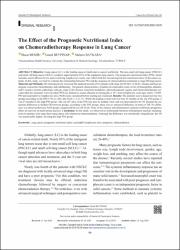The Effect of the Prognostic Nutritional Index on Chemoradiotherapy Response in Lung Cancer
Abstract
Objective: Lung cancer (LC) is the leading cause of death due to cancer worldwide. The non-small cell lung cancer (NSCLC) and small cell lung cancer (SCLC) comprise approximately 85% of the malignant lung tumors. The prognostic nutritional index (PNI), which includes serum albumin levels and circulating lymphocyte counts, can reflect both the immunological and nutritional status of the cancer patients. In this study, we tried to evaluate the relationship between PNI and the response of chemoradiation treatment in stage III lung cancer. Material and Methods: We retrospectively reviewed the medical records of 63 patients with stage III NCSLC or SCLC disease and had undergone concurrent chemotherapy and radiotherapy. The patient characteristics, lymphocyte-neutrophil count, levels of hemoglobin, albumin, and C-reactive protein, pathologic subtype, stage of the disease, treatment modalities, chemotherapeutic agents, and chemoradiotherapy outcome after the treatment were recorded. PNI was defined as serum albumin levels(mg/dL) x 10 + total lymphocyte count (per mm3) x 0.005. PNI and neutrophil to lymphocyte ratio (NLR) were calculated before starting any treatment. Results: The patients were categorized into two groups according to the PNI (<50 or ?50), and NLR (<.3 or ?3). While the median overall survival was 16 months in the low PNI group, it was 27 months in the high PNI group. The cut-off value of the PNI was also its median value and was determined to be 50. Despite the numerical difference in median OS between groups, according to the PNI groups, there was no statistical difference in terms of OS. No difference was observed between NLR groups categorized for cut-off levels. None of the clinical and inflammatory markers exhibited a prognostic effect on survival in multivariate analysis. Conclusion: In this study, we observed no relationship between inflammatory markers and prognosis in patients with stage three lung cancer who underwent chemoradiation. Although the difference was statistically insignificant, the OS was numerically higher, favoring the high PNI group.
Source
Journal of oncological sciencesVolume
6Issue
2URI
https://doi.org/10.37047/JOS.2020-75476https://app.trdizin.gov.tr/makale/TXpVMU1Ua3lNZz09
https://hdl.handle.net/20.500.12933/439
















